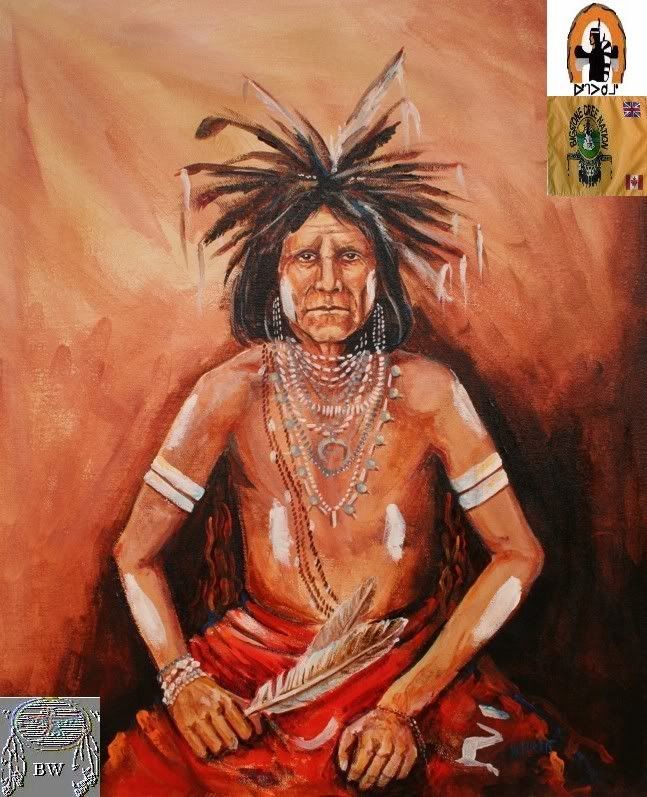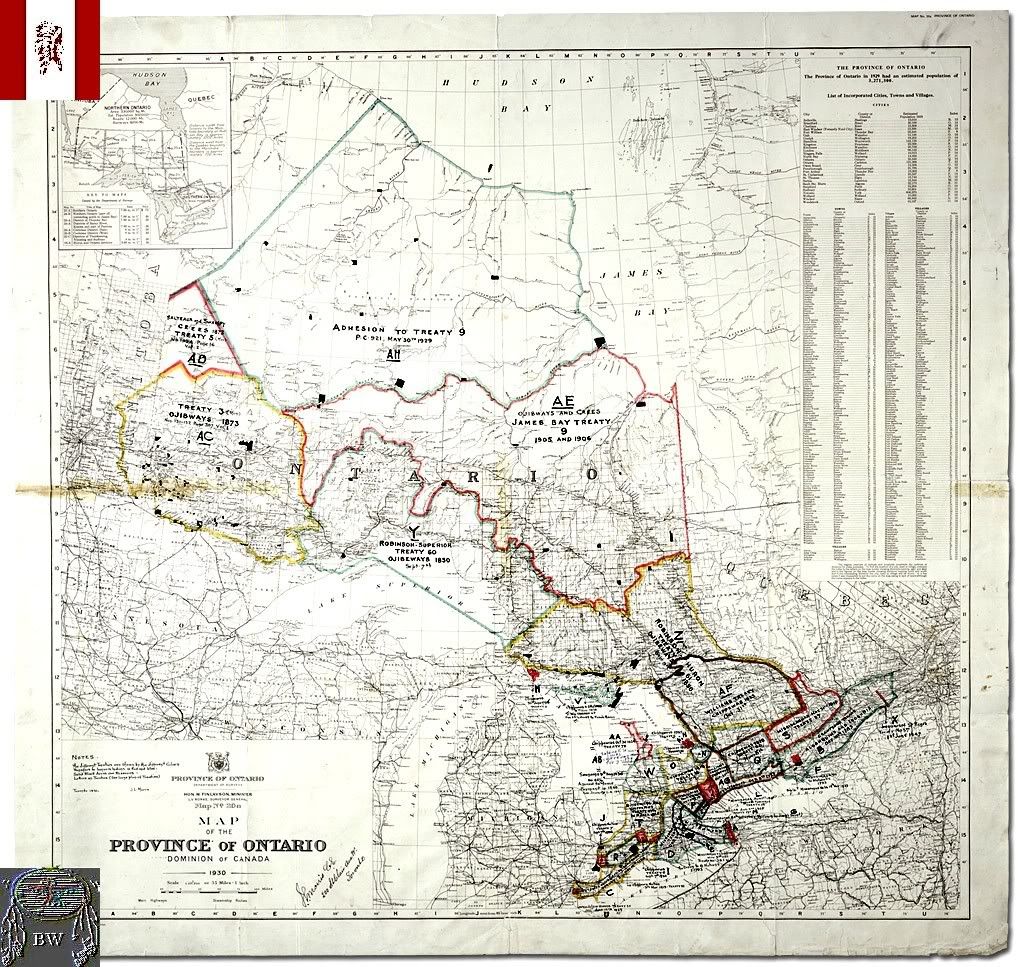|
BRAVEHORSE WARRIOR Mysymin
Cree Warrior

 Chief Squashberry
Warrior Citation
M„S„MIN (Moosomin, translated as “low-bush cranberry” or “squashberry”), chief of a Cree and Saulteaux
band; probably b. in what is now Saskatchewan; d. 24 March 1902 on the Moosomin Reserve (Sask.): M‡s‡min was a
member of a band that wintered north of the North Saskatchewan River in the vicinity of Jackfish and Turtle lakes (Sask.).
Like their close neighbours the band of Big Bear [Mistahimaskwa], they combined a woodland and a plains economy, trapping,
hunting, and fishing in the parkland in winter, and hunting buffalo on the open grasslands in summer. They were led by Yellow
Sky when Treaty No.6 was negotiated at Fort Pitt in 1876, but he refused to sign the documents. In 1879 M‡s‡min
and 124 followers, mostly Cree, asked to be admitted to the treaty and to have their own reserve. A tract 12 miles northwest
of Battleford was surveyed for them in 1881. The band was among those that followed the lead of Poundmaker [P§tikwahanapiw§yin]
and, as a protest over treaty promises that had not been kept, refused initially to sow a crop in the spring of 1881. Their
efforts at agriculture none the less soon resulted in a surplus and they also burned lime and charcoal for sale. These achievements
were regarded as particularly notable because it was estimated that there were only 12 able-bodied males among them in the
early 1880s, out of the reserve’s population of 70 residents.
Chief Squashberry
Warrior Citation
M„S„MIN (Moosomin, translated as “low-bush cranberry” or “squashberry”), chief of a Cree and Saulteaux
band; probably b. in what is now Saskatchewan; d. 24 March 1902 on the Moosomin Reserve (Sask.): M‡s‡min was a
member of a band that wintered north of the North Saskatchewan River in the vicinity of Jackfish and Turtle lakes (Sask.).
Like their close neighbours the band of Big Bear [Mistahimaskwa], they combined a woodland and a plains economy, trapping,
hunting, and fishing in the parkland in winter, and hunting buffalo on the open grasslands in summer. They were led by Yellow
Sky when Treaty No.6 was negotiated at Fort Pitt in 1876, but he refused to sign the documents. In 1879 M‡s‡min
and 124 followers, mostly Cree, asked to be admitted to the treaty and to have their own reserve. A tract 12 miles northwest
of Battleford was surveyed for them in 1881. The band was among those that followed the lead of Poundmaker [P§tikwahanapiw§yin]
and, as a protest over treaty promises that had not been kept, refused initially to sow a crop in the spring of 1881. Their
efforts at agriculture none the less soon resulted in a surplus and they also burned lime and charcoal for sale. These achievements
were regarded as particularly notable because it was estimated that there were only 12 able-bodied males among them in the
early 1880s, out of the reserve’s population of 70 residents.
 In June 1884 M‡s‡min and his followers were among the two thousand people who attended a Thirst Dance and
grand council on the Poundmaker and Little Pine reserves at which common grievances were discussed. Government authorities
did not regard M‡s‡min’s people as likely to participate in any armed protest. Native American commissioner
Edgar Dewdney was informed in February 1885 that “the majority of these men are among the most peaceable and reliable
Indians in the district.” During the resistance of 1885, M‡s‡min and his band left their reserve because
they lacked food and because they wished to keep out of the way of disturbance. A farm instructor on a nearby reserve explained
in later years that, unlike the Plains Cree, the primarily woodland inhabitants of the Moosomin Reserve had no experience
of battle and preferred to avoid involvement. They risked great danger in crossing the North Saskatchewan with their outfits
and animals when the ice had not yet all gone out. They did not succeed, however, in escaping confrontation. Government spokesmen
subsequently stated that M‡s‡min and his band approached the town of Battleford because of hunger but then, “thinking
that the incensed settlers would not make any discrimination between loyal and disloyal Native Americans,” went some
miles west to Poundmaker’s camp to save themselves from starvation. The non-native citizens of Battleford and district,
such as Patrick Gammie Laurie, nevertheless believed themselves to be under siege and took refuge within the stockade of the
North-West Mounted Police fort just outside the town. At one stage of the troubles M‡s‡min was instructed by the
military authorities to “keep up communication” with the fort, but “some persons in it fired upon him, and
he had to retreat.” It may have been this incident that caused M‡s‡min to don the British flag. The wife
of one policeman wrote some years after “of old ‘Moosomin’ a Cree chief who went about with a tattered Union
Jack draped over his shoulders to show that he and his had no sympathy with the followers of Louis Riel.” M‡s‡min’s
peaceful intentions were never doubted by the authorities, despite the fact that early in May some members of his band fought
with Poundmaker against Lieutenant-Colonel William Dillon Otter near Cut Knife Hill. At the end of May, when the troubles
had subsided, the chief was “well-received” at Battleford. Major-General Frederick Dobson Middleton shook hands
with him though he apparently refused to do so with any other Native American. In his report for 1885 Dewdney used the Moosomin
band as an example of the contented native people of the west, most of whom had not “rebelled.” He noted also
that the band had accumulated enough money in their account to purchase one hundred sheep, and he attributed this achievement
to the department’s policy of distributing rations only when work was performed. M‡s‡min’s people
continued to meet with moderate success in their farming and stock raising. By the late 1880s they had purchased machinery
such as self-binders and mowers, but agricultural development on the reserve was detrimentally affected by government policies
enforced in the 1890s, which were intended to ensure that farmers on Native American reserves did not raise enough surplus
to compete with the surrounding settlers. M‡s‡min himself died on 24 March 1902. From: historical accounts & records
In June 1884 M‡s‡min and his followers were among the two thousand people who attended a Thirst Dance and
grand council on the Poundmaker and Little Pine reserves at which common grievances were discussed. Government authorities
did not regard M‡s‡min’s people as likely to participate in any armed protest. Native American commissioner
Edgar Dewdney was informed in February 1885 that “the majority of these men are among the most peaceable and reliable
Indians in the district.” During the resistance of 1885, M‡s‡min and his band left their reserve because
they lacked food and because they wished to keep out of the way of disturbance. A farm instructor on a nearby reserve explained
in later years that, unlike the Plains Cree, the primarily woodland inhabitants of the Moosomin Reserve had no experience
of battle and preferred to avoid involvement. They risked great danger in crossing the North Saskatchewan with their outfits
and animals when the ice had not yet all gone out. They did not succeed, however, in escaping confrontation. Government spokesmen
subsequently stated that M‡s‡min and his band approached the town of Battleford because of hunger but then, “thinking
that the incensed settlers would not make any discrimination between loyal and disloyal Native Americans,” went some
miles west to Poundmaker’s camp to save themselves from starvation. The non-native citizens of Battleford and district,
such as Patrick Gammie Laurie, nevertheless believed themselves to be under siege and took refuge within the stockade of the
North-West Mounted Police fort just outside the town. At one stage of the troubles M‡s‡min was instructed by the
military authorities to “keep up communication” with the fort, but “some persons in it fired upon him, and
he had to retreat.” It may have been this incident that caused M‡s‡min to don the British flag. The wife
of one policeman wrote some years after “of old ‘Moosomin’ a Cree chief who went about with a tattered Union
Jack draped over his shoulders to show that he and his had no sympathy with the followers of Louis Riel.” M‡s‡min’s
peaceful intentions were never doubted by the authorities, despite the fact that early in May some members of his band fought
with Poundmaker against Lieutenant-Colonel William Dillon Otter near Cut Knife Hill. At the end of May, when the troubles
had subsided, the chief was “well-received” at Battleford. Major-General Frederick Dobson Middleton shook hands
with him though he apparently refused to do so with any other Native American. In his report for 1885 Dewdney used the Moosomin
band as an example of the contented native people of the west, most of whom had not “rebelled.” He noted also
that the band had accumulated enough money in their account to purchase one hundred sheep, and he attributed this achievement
to the department’s policy of distributing rations only when work was performed. M‡s‡min’s people
continued to meet with moderate success in their farming and stock raising. By the late 1880s they had purchased machinery
such as self-binders and mowers, but agricultural development on the reserve was detrimentally affected by government policies
enforced in the 1890s, which were intended to ensure that farmers on Native American reserves did not raise enough surplus
to compete with the surrounding settlers. M‡s‡min himself died on 24 March 1902. From: historical accounts & records
|

